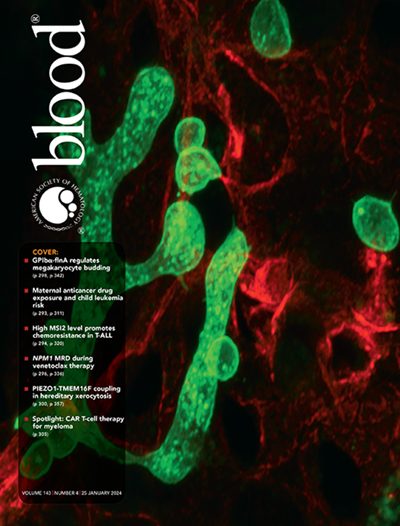A noncoding mutation in the NOTCH1 gene initiates oncogenic NOTCH signaling via wild-type NICD stabilization in CLL.
IF 21
1区 医学
Q1 HEMATOLOGY
引用次数: 0
Abstract
Chronic Lymphocytic Leukemia (CLL) is the most common chronic blood cancer in adults. Active NOTCH signaling in CLL is associated with poorer prognosis. Importantly, CLL patients with NOTCH1 non-coding mutations in the 3-prime untranslated region (3'UTR) manifested with a more aggressive disease course even compared to those with mutations in the NOTCH1 coding region. Here, we comprehensively characterize a cryptic splice acceptor site in 3'UTR of the NOTCH1 gene being converted into a stronger site. The functional consequences of the resulting NOTCH1 protein variants depend on the exact localization of the splice site, the used open reading frame and the appearance of the next STOP codon. The most frequent 3'UTR mutation (g.139390152, A>G) generates a novel NOTCH1 protein, lacking the PEST domain but expressing an altered C-terminus consisting of 68 amino acids. Mechanistically, we show that this splice variant (NOTCH1 152) is transcriptionally less active and dysregulates the regular ubiquitination dependent degradation of the wild type NOTCH1 intracellular domain (NICD) in trans. Thus, the NOTCH1 152 variant acts as a "sponge" protein in a novel mechanism of oncogenic NOTCH signaling activation, explaining the detrimental disease outcome of CLL patients with non-coding NOTCH1 mutations. We propose that the detection of NOTCH1 152 protein by specific antibodies is a useful prognostic marker for CLL patients.NOTCH1基因的非编码突变通过野生型NICD稳定在CLL中启动致癌NOTCH信号。
慢性淋巴细胞白血病(CLL)是成人最常见的慢性血癌。活性NOTCH信号在CLL中与较差的预后相关。重要的是,与NOTCH1编码区突变的CLL患者相比,在3‘非翻译区(3’UTR)具有NOTCH1非编码突变的患者表现出更具侵袭性的病程。在这里,我们全面表征了NOTCH1基因3'UTR中的一个隐剪接受体位点被转化为一个更强的位点。由此产生的NOTCH1蛋白变异的功能后果取决于剪接位点的确切定位、使用的开放阅读框和下一个停止密码子的出现。最常见的3'UTR突变(G .139390152, A>G)产生一个新的NOTCH1蛋白,缺乏PEST结构域,但表达一个由68个氨基酸组成的改变的c端。在机制上,我们发现这种剪接变体(notch1152)转录活性较低,并且在反式中失调了野生型NOTCH1细胞内结构域(NICD)的泛素化依赖性降解。因此,NOTCH1 152变体在致癌NOTCH信号激活的新机制中充当“海绵”蛋白,解释了非编码NOTCH1突变的CLL患者的有害疾病结局。我们认为特异性抗体检测NOTCH1 152蛋白是CLL患者的一个有用的预后标志物。
本文章由计算机程序翻译,如有差异,请以英文原文为准。
求助全文
约1分钟内获得全文
求助全文
来源期刊

Blood
医学-血液学
CiteScore
23.60
自引率
3.90%
发文量
955
审稿时长
1 months
期刊介绍:
Blood, the official journal of the American Society of Hematology, published online and in print, provides an international forum for the publication of original articles describing basic laboratory, translational, and clinical investigations in hematology. Primary research articles will be published under the following scientific categories: Clinical Trials and Observations; Gene Therapy; Hematopoiesis and Stem Cells; Immunobiology and Immunotherapy scope; Myeloid Neoplasia; Lymphoid Neoplasia; Phagocytes, Granulocytes and Myelopoiesis; Platelets and Thrombopoiesis; Red Cells, Iron and Erythropoiesis; Thrombosis and Hemostasis; Transfusion Medicine; Transplantation; and Vascular Biology. Papers can be listed under more than one category as appropriate.
 求助内容:
求助内容: 应助结果提醒方式:
应助结果提醒方式:


